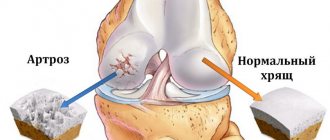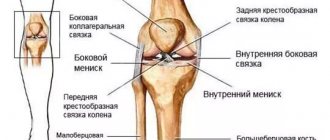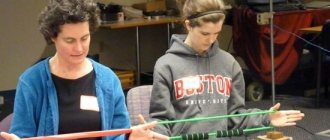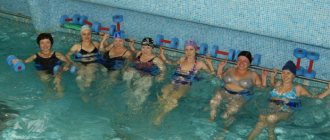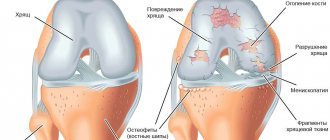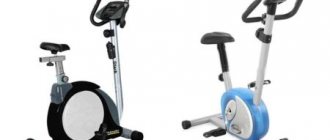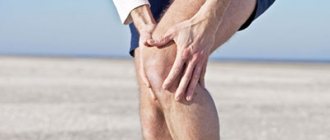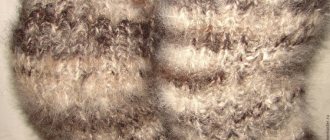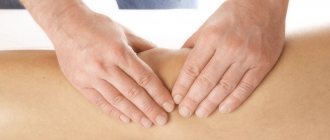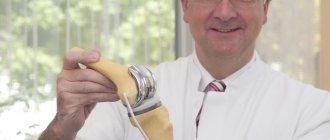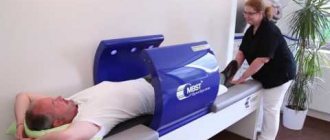Recently, the population of people suffering from arthrosis has been steadily getting younger, which means that rheumatologists’ patients are often young people with an active lifestyle. For most, the cause of the disease is a previous injury; many are accustomed to playing sports, but due to circumstances they are forced to give up their usual activities. What kind of physical exercise is safe for such a diagnosis?
Do you have knee arthrosis? Need a special set of exercises
The basic principle of physical activity for knee arthrosis
As a rule, at the initial stage of treatment of arthrosis or osteoarthritis, there is a limitation of mobility - minimal or more significant. Therefore, along with other therapeutic and preventive measures, it is necessary to work on lost movements.
For example, you notice that discomfort occurs when bending your knee. This means that you need to work on this particular movement, but it should be low-amplitude (no more than 1 cm), oscillatory, and as long as possible. If after training the knee joint begins to move in this direction a little more, the discomfort has decreased - you did everything right. You should not be afraid of short-term pain if it is followed by improvement.
Low-amplitude movements can do wonders for joints if performed regularly
Wall Squats
Stand with your back to the wall, looking straight ahead. Feet shoulder-width apart and at a distance of 40-50 cm from the wall. Squat down slowly until your thighs are almost parallel to the floor. Hold this position for 10 seconds. Smoothly return to the starting position. 2 sets of 15 reps. Gradually increase the hold time to better strengthen the quadriceps muscle.
What exercises for arthrosis are safe for joints?
In fact, none of the exercises with such a diagnosis is absolutely safe. The main condition when performing any of them is to limit the load on the joint. This task is ideally handled by low-amplitude movements that cause minimal pain. They certainly will not restore the viscosity of the synovial fluid, but they may well increase joint mobility with regular exercise.
At the next stage, you can connect swings. They must be performed using the initial impulse so that the limb continues to fly by inertia and does not have to apply force. This will reduce the stress on the knee joint, but will allow the surrounding muscles and ligaments to develop.
Once the swings are mastered, you can carefully begin stretching exercises. As a rule, they are accompanied by pain, since efforts have to be made to increase the range of motion. A few repetitions are enough, without excessive pain, and finally - a swing complex or light rocking. If you are not sure that you can perform stretching exercises safely, it is better not to experiment and limit yourself to swings.
Leg swings are the safest and most effective exercise for knee mobility.
If you have osteoarthritis of the knee joints, you must do special exercises every day. These exercises strengthen the cartilage itself, which requires movement for normal nutrition. Regular exercise therapy should transform from an unpleasant chore into a healthy habit, which is the best way to maintain normal joint function. You need to practice for at least 30–40 minutes. per day, it is better to divide this time into several times for 10–15 minutes. A noticeable effect occurs within 2–3 months. - pain decreases, vitality increases.
Exercises for patients with osteoarthritis of the knee joints
For osteoarthritis of the knee joints, physical exercises should be done in a lying or sitting position, when the weight load on the joints is minimized. Exercises should not be done through pain; it is better to start them after taking painkillers. The intensity of the exercises and frequency of repetitions are determined by the severity of joint pain. Vigorous movements are contraindicated. There are no age restrictions for physical activities. It should be remembered that in addition to the positive emotional charge, physical activity also helps strengthen the cardiovascular system and bone tissue. The range of movements should be increased gradually. The main principle is to repeat the exercises frequently throughout the day for several minutes. Exercises should be performed slowly, smoothly, gradually increasing the range of movements. In this case, it is better to focus on the sore joint, think about how, during movements, blood flows to the joint, bringing with it nutrients that, when the limb relaxes, nourish the cartilage, and during movements are squeezed into the joint cavity, providing good “lubrication” to the joint.
For most patients, these exercises will not cause increased joint pain. If, however, significant pain continues more than 20 minutes after performing the exercises, then you need to reduce the number of repetitions to 5 exercises at a time, then gradually increase their number to 15 when your health allows.
Set of exercises No. 1
each exercise at least 5 times.
Sitting on the table
- Sit on the table top. Sit straight. Swing your legs with a moderate range of motion. Do this exercise as often as possible.
- In the same position. Raise your leg and hold it parallel to the floor for 3 seconds. The foot is at a right angle to the shin. Change leg. When performing this exercise, you need to feel the tension in the muscles of the thigh and lower leg.
- Standing on the floor, rest your buttocks on the tabletop. The knees are slightly bent and apart. Toes to the sides. Without bending your back, lean forward and go back.
Lying on the floor in a supine position
- Legs extended. Bend your knee, while raising your foot slightly above the floor. Hold this for 5 seconds. Change legs. Repeat 5 times.
- "Small bike" Bend both knees, feet on the floor. Bring your right leg to your stomach with your knee, then straighten it, slowly lower it to the floor and bring it back to the second leg. The foot is always at a right angle. Change legs.
- "Big bike" Swing your legs like you would when riding a bicycle. Perform slowly at first, then faster; slower - faster. Always pay attention to the tension in the thigh muscles.
- Bend your leg at the knee, grab your thigh with your hand and pull it towards your stomach. Extend the knee (foot at a right angle, “pull” the heel). Feel the tension in the muscles. Hold this for 5–8 seconds. Lower your heel to the floor, then extend your leg. Change legs one by one. Try not to bend the other leg, which is on the floor.
Lying on your side with a small pillow under your cheek
- Lying on your right side, your right hand under the pillow, your left hand resting on the floor in front of you. The right leg is half bent. The left leg is bent at the knee, brought to the stomach, then pulled back as far as possible. Do the exercise slowly.
- The position is the same (on the right side). The left leg is bent and the knee rests on the floor. The right leg is extended and lifted off the floor by 25–30 cm.
- The same exercises on the left side.
Lying on your stomach
- Lying on your stomach, bend your knees alternately. Make sure that the pelvis does not come off the floor.
- In the same position, bend your leg at the knee and hold for 5–10 seconds. Change legs.
Set of exercises No. 2
each exercise at least 5 times.
Supine position
- Legs are extended and relaxed. On the “one-two” count, the leg bends at the knee joint to the maximum, while the foot slides along the mat. On the count of “three,” the leg is bent at the hip joint and pressed against the body with your hands (do not lift your back from the floor). On the count of four to five, hold your leg. On the count of six, lower your foot to the floor. On the count of “seven-eight” we straighten the leg. The same movement is repeated with the other leg. Repeat 10–15 times.
- Legs are bent. The bent leg is lifted off the floor and pressed to the chest with the help of your hands and held in this position for several seconds, then lowered. The same movement is repeated with the other leg. Repeat 10 times.
- The straightened leg is lifted off the floor to a height of 20–30 cm and held in this position for several seconds, then lowered. The same movement is repeated with the other leg. Repeat 20–30 times.
- Legs extended. Extend your arms forward and try to raise your head and upper torso to a height of 20 cm from the floor, then lower them. Repeat 10 times.
- Simulation of cycling. The legs are raised above the mat throughout the entire exercise. Repeat from 20 to 50 times or more. Exercises 2 and 3 are also useful for the hip joint.
Pronation
- We alternately bend our legs at the knee joints, trying to touch the buttock with the heel. Do not lift your hips off the floor. Can be performed with a load (sandbags or special dumbbells are placed on the feet). Repeat 20 to 50 times.
Sitting position on the floor
- Legs straightened. We clasp our feet with our hands and lean forward as much as possible, trying to touch our foreheads to our feet. Do not bend your knee joints. Stay in this position as long as possible. Return to starting position. Shake your legs. Repeat 3-5 times.
- We bend the leg at the knee joint, clasp the foot with both hands, lift the leg off the floor and try to straighten it without unclenching our hands. We hold in this position as long as possible. We return to the starting position. We repeat the same with the other leg.
An unconventional approach to exercise therapy: shiatsu for arthrosis
Shiatsu is a healing and healing system that is based on healing pressures. Practitioners are convinced that this is the easiest way to restore mobility to a damaged joint. The principle is simple: while performing exercises, you must gently press on the sore spot and do not release the pressure during physical activity.
Is it worth experimenting? Yes, if you have become acquainted with the theoretical foundations of this technique, talked with a specialist and are confident that you will not harm yourself. Otherwise, treatment of arthrosis or osteoarthritis may be delayed, since the disease will worsen due to improper impact on the damaged joint.
If, in addition to physical education, you add these 5 products to your diet, the likelihood of successfully fighting arthrosis, according to some experts, increases significantly. What are these products?
Recommendations that need to be carried out simultaneously with charging
To consolidate the effect obtained through proper exercise therapy, patients with arthrosis should adhere to the following recommendations.
| Recommendation | Purpose of her appointment | Additional tip |
| Wearing low, stable heels | Maintaining center of gravity, reducing pain | Walk with a cane, use insoles, wear knee pads |
| Sleep only on a flat surface, without using a pillow | Prevention of muscle tension, increased discomfort in joint structures | Purchase an orthopedic mattress that evenly distributes the load on the musculoskeletal system |
| Brief warm-up every 30 minutes | Prevention of prolonged stay in fixed positions | Avoid physical movements that involve jerking |
| When working at a computer or while driving, keep your back straight, with maximum extension in the lumbar region | Increasing the respiratory capacity of the lungs, alleviating the patient’s pain, strengthening the muscular and musculoskeletal system | If it is not possible to keep your back in the correct position, it is advisable to use a corset - a posture corrector |
We must not forget that the benefits of physical therapy for arthrosis must be consolidated using physiotherapeutic methods . However, the joint must be in remission. It is also contraindicated to intensively massage the affected area.
What should I do?
Orthopedic rheumatologists take different approaches and give completely different recommendations to patients. Some people advise losing weight or giving up calcium-rich foods. More progressive doctors introduce the Noltrex intra-articular injection technique, after a course of which mobility is restored and pain goes away.
With any approach, it is important to ensure adequate mobility of the joint. That is why a variety of physical activity, within reasonable limits, is considered the best prevention of arthrosis, even after treatment or other intervention. Movement is life. Move, pay attention to your joints - live with pleasure!
Reverse leg tension
Lying on your stomach, legs straight, hands under your head. Pull in your stomach, tense and lift the leg you are working on 20 cm from the floor. Hold the straight leg in this position for 5 seconds, then relax and return the leg to the starting position. 2 sets of 15 reps.
Exercises with an expander
Attach one end of the expander to the ankle of your healthy leg, and the other end to a door or other stationary object at ankle level.
Execution Rules
Before you start doing therapeutic exercises for arthrosis, you should definitely consult a specialist. This will allow you to select the optimal complex.
The basic rules of implementation are simple:
- Exercises are performed only during remission; if the disease worsens, you should refrain from training.
- Movements should be enjoyable; in no case is it recommended to perform the complex through force or endure pain.
- It is optimal to exercise in the fresh air; you can combine exercise with massage or swimming.
- Training should be regular - it is better to exercise every day for 20 minutes than once a week for an hour and a half.
All movements are aimed at developing the knee joint affected by grade 1-2 gonarthrosis, strengthening and building muscles, and normalizing metabolic processes in the joint. Stabilization of the patient’s psycho-emotional state also plays an important role. Gymnastics for gonarthrosis allows the patient, exhausted by pain, to calm down and again believe that an active life without pain is possible.
To make physical therapy enjoyable, you need to take care of everything:
- Comfortable shoes, preferably made from natural materials. The sole must be sufficiently hard and reliable. There should be arch supports to support the foot.
- Comfortable clothing that does not restrict movement.
- About the mat needed to perform the exercises.
- A chair can easily serve as a support at home. It needs to be stable enough.
Ways to strengthen knee ligaments
Physiotherapy specialists have developed quite a lot of exercises designed to strengthen knee ligaments, most of which are distinguished by the fact that they are aimed at certain groups of people who have various types of pathologies and depending on age. Thus, post-traumatic rehabilitation of knee ligaments is possible with the help of special exercises that allow you to develop the elasticity of joints and muscles and avoid similar injuries in the future.
The main complex that helps to cope with the problem indicated above is the following exercises:
- Standing on the floor, you need to place the foot of your left foot in front of your right, and raise your arms up. In this position, you need to perform several bends to the left, and then, placing the foot of your right foot in front of your left, bend to the right.
- Sitting on the mat, you should stretch your legs in front of you and place your right leg on top of your left, while pulling your knee so that it touches your chest. After sitting in this position for a while, you need to change legs and perform the exercise again, but on the other leg.
Tensor fascia lata stretch
The tensor fascia lata is a small muscle located on the side of the thigh just below the pelvic process. When overused and tight, this muscle can pull the knee through the iliotibial band, causing pain on the outside of the knee.
- How to do it. Again we will use a multi-purpose tape or elastic bandage. Attach one end of the loop to a stationary object, and secure the other around the buttock. Kneel with your taped leg behind you (think of a lunge with one leg on your knee). Maintain an upright torso position and turn your taped toe out (turn your hip inward). When rotating your leg, you can properly target the tensor fascia lata, as this area is difficult to stretch. Squeeze the gluteal muscle on the side of your leg with the band to achieve maximum stretch for the tensor fasciae lata.
After a knee fracture
When a fracture occurs, not only the bones are damaged, but also the ligaments. After an injury, it is necessary to remain at rest, fixing the limb in a motionless state. Once the injury has healed, you can move on to exercise.
What to do:
- Before surgery, you may be able to move your toes to exercise this muscle group.
- After surgery due to a fracture, it is allowed to perform exercises in bed on the first day. You should not put any weight on your leg or exercise through severe pain.
- The doctor will tell you when you can start walking. The recovery stage lasts up to six months, you can do Bubnovsky exercises.
All training is carried out under the strict supervision of a doctor.
Causes of knee problems
Before we talk about how to cope with knee injuries, you should understand what are the causes that provoke this disease and, accordingly, what ways to overcome this dangerous disease exist.
Among the most common problems arising in the knee joint are:
- obesity, manifested in heavy physical activity on the knee area and leading to a decrease in cartilage tissue;
- lack of an active lifestyle;
- improper nutritional system, as a result of which the joints are not saturated with necessary nutrients, which weakens both cartilage and bone tissue, and also leads to the development of a number of diseases;
- excessive physical activity, which involves training when the knee and its joints are injured, subject to fractures or meniscal tears;
- metabolic problems;
- frostbite, which causes inflammation in the knee joint;
- hormonal imbalances in the body;
- presence of bad habits;
- hereditary diseases or congenital problems associated with weakening of the musculoskeletal system.
It should be said that the role of seemingly minor injuries in the progression of irreversible changes in the knee joint is often underestimated. For this reason, in case of a knee injury, you must immediately consult a doctor; only in this case is it possible to avoid serious consequences.
